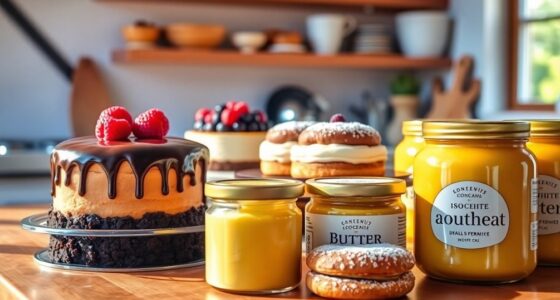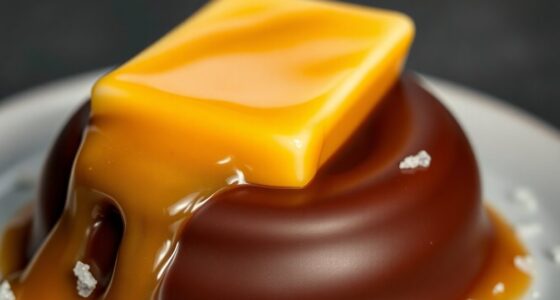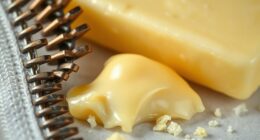If you're looking to celebrate butter's rich flavor in your desserts, five-ingredient recipes are perfect! Butter transforms simple combinations into delectable treats, adding texture and depth. Classic options like gooey butter cake, buttery cookies, and brownies showcase how this versatile ingredient enhances taste. Using quality butter can elevate your baking to new heights. Want to discover more about these delightful desserts and how to make them? There's plenty more to savor ahead!
Key Takeaways
- Butter enhances the flavor and texture of desserts, making it an essential ingredient in 5-ingredient recipes like gooey butter cake and cookies.
- Simple 5-ingredient desserts highlight butter's richness, allowing for delightful combinations without overwhelming complexity.
- Using high-quality butter, such as European-style or grass-fed, can elevate the nutritional profile and taste of baked goods.
- Browning butter adds a nutty flavor, enriching desserts while keeping the ingredient list minimal.
- Experimenting with seasonal ingredients and flavor extracts can create unique 5-ingredient desserts that celebrate butter's versatility.
History
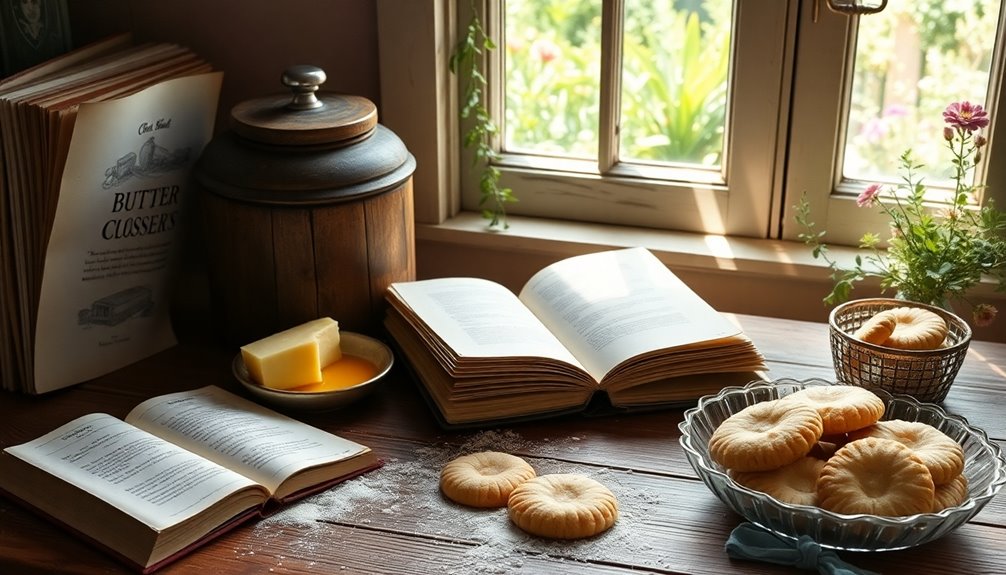
When you think about the history of desserts, it's fascinating to note that the use of butter in baking stretches back to ancient times, with the Romans already incorporating it into their recipes.
In the 17th century, the French popularized butter in pastries, paving the way for countless classic desserts.
The original pound cake, with its equal parts of butter, flour, sugar, and eggs, emerged in the 1700s in England, celebrated for its simplicity and rich flavor.
By the 19th century, creamery butter had enhanced the texture and taste of desserts, solidifying its role in baking.
In the 20th century, butter became essential in American home baking, particularly in rich butter cakes and cookies, often paired with baking soda for leavening. Additionally, the historical understanding of butter's evolution in culinary traditions underscores its enduring importance in dessert recipes.
Recipe
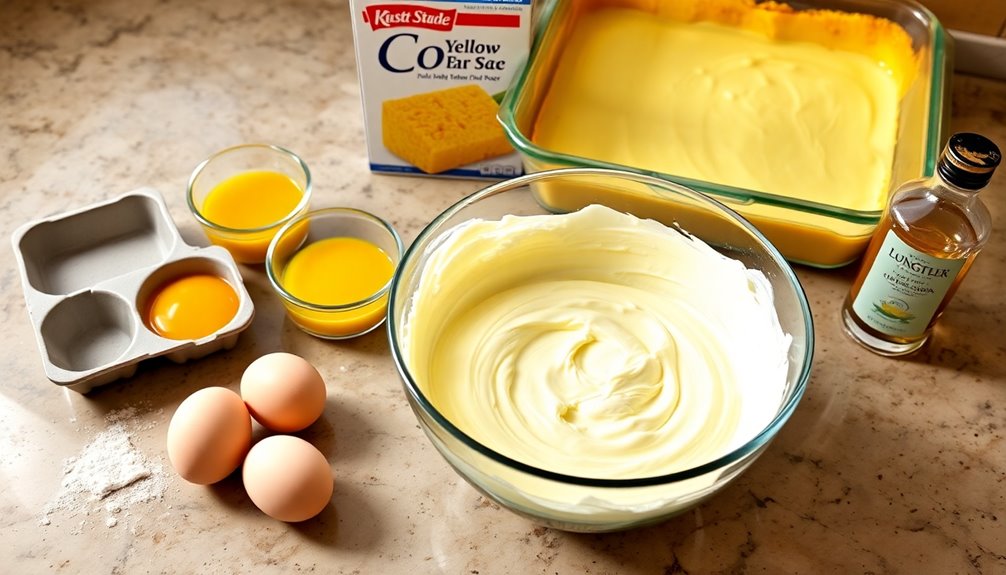
Ingredients:
- 1 box of yellow cake mix
- 1/2 cup of unsalted butter, melted
- 2 large eggs
- 8 oz cream cheese, softened
- 4 cups powdered sugar
Instructions:
Preheat your oven to 350°F (175°C) and grease a 9×13-inch baking dish.
In a mixing bowl, combine the yellow cake mix, melted butter, and one egg until well blended. Press this mixture evenly into the bottom of the prepared baking dish to form the crust.
In another bowl, beat together the softened cream cheese, remaining egg, and powdered sugar until smooth and creamy.
Pour this cream cheese mixture over the crust layer in the baking dish.
Bake for 40-45 minutes, or until the center is set and the edges are golden. Allow the cake to cool before cutting into squares.
Extra Tips:
For an extra burst of flavor, consider adding a teaspoon of vanilla extract to the cream cheese mixture or a sprinkle of lemon zest to brighten the taste. Additionally, using unsalted sweet cream butter can help you achieve precise flavor control in your dessert.
Make sure not to overbake the cake; it should remain gooey in the center, so keep an eye on it as it nears the end of the baking time.
Serve chilled or at room temperature, and dust with additional powdered sugar for an elegant touch.
Enjoy your gooey butter cake with a scoop of vanilla ice cream for a delightful contrast in textures!
Cooking Steps
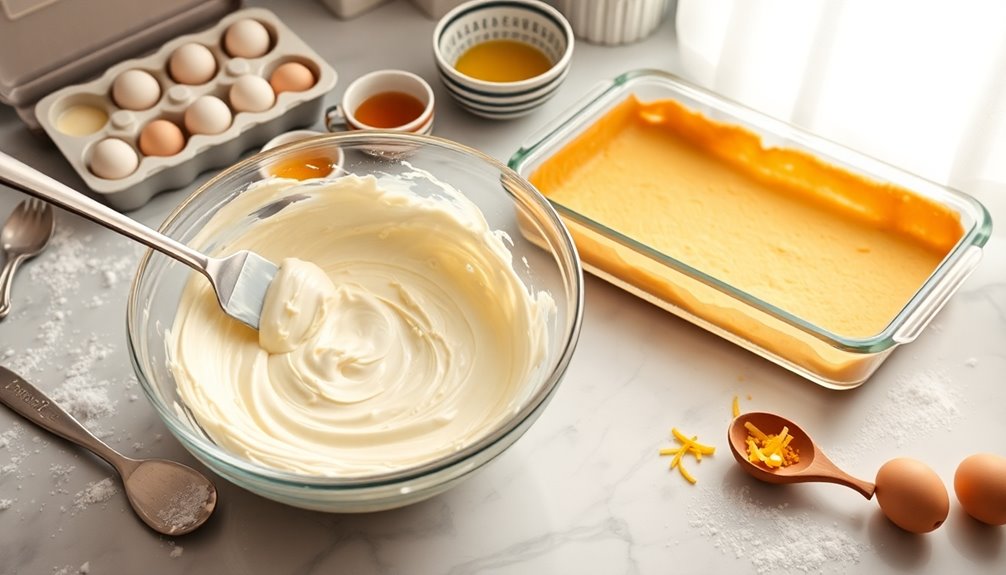
To start your 5-ingredient dessert, preheat your oven to 350°F, so it's ready when you are.
Next, mix your dry ingredients thoroughly to ensure even flavor throughout.
Then, you can incorporate the wet ingredients gradually, folding in the butter and adding any flavor extracts for that extra touch. Butter enhances flavor in baked goods, making it a crucial ingredient in your dessert.
Step 1. Preheat Oven to 350°F
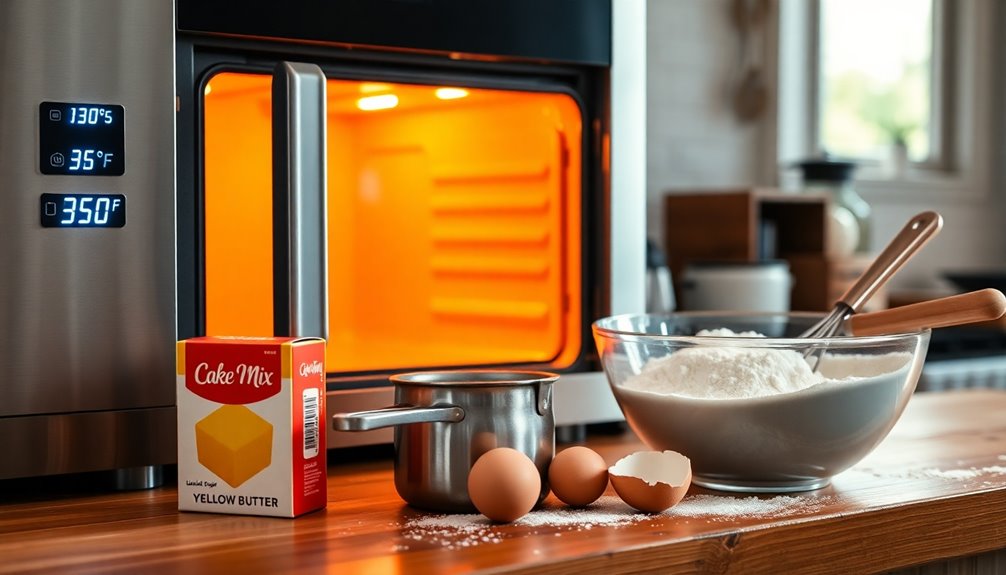
Preheating your oven to 350°F is a crucial step for baking delicious desserts. This temperature is vital for achieving that perfect texture in buttery desserts like cookies and rich cakes.
Take about 10-15 minutes to preheat your oven; this ensures it reaches the right temperature before you place your dish inside. If you want to be extra precise, consider using an oven thermometer to confirm your oven's calibration—many can be off by several degrees.
Remember, placing your dessert in the oven before it's fully preheated can lead to uneven cooking.
Also, keep in mind that factors like bakeware size and material can affect baking time, so be ready to make adjustments if needed.
Step 2. Mix Dry Ingredients Thoroughly
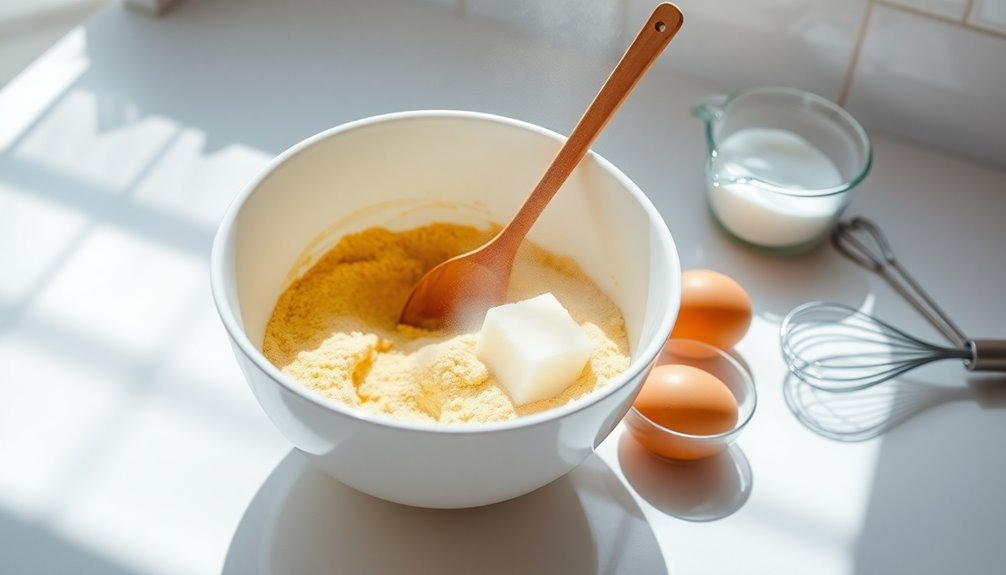
When you mix dry ingredients thoroughly, you're setting the stage for a well-risen dessert. Start by accurately measuring flour, baking powder, and sugar.
Use a whisk or sifter to combine these ingredients, which aerates the mixture and prevents clumping. This step is crucial for achieving a light and fluffy cake texture.
Remember, even slight variations in measurements can impact the density and overall success of your dessert. Following the recipe's order of mixing is vital; for instance, creaming butter and sugar before adding dry ingredients enhances flavor and texture.
Once mixed, you'll be ready to incorporate the wet ingredients, ensuring your cake shines with buttery richness and a hint of vanilla.
Step 3. Incorporate Wet Ingredients Gradually
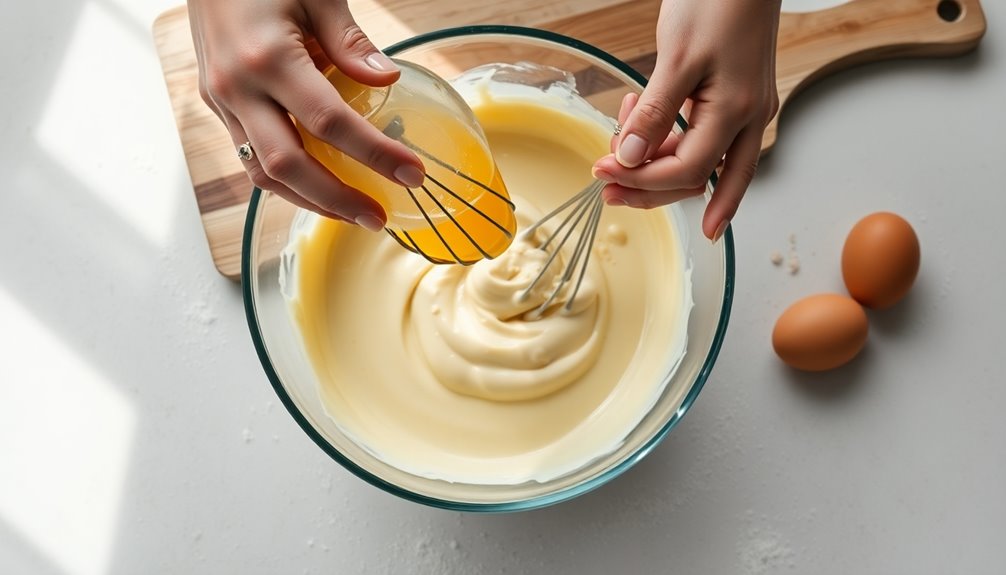
After mixing your dry ingredients thoroughly, it's time to incorporate the wet ingredients gradually.
Start by adding a small amount of cream cheese and vanilla extract to your yellow cake mix. Mix it thoroughly before adding more liquid to ensure an even consistency. This step is crucial for achieving that light and fluffy texture in your cake. Additionally, using unsalted butter in your recipe will allow for better control over the overall saltiness.
As you continue, introduce your whipped cream and any remaining wet ingredients one at a time. Use a spatula or a mixer on low speed to blend everything together without overmixing, which can lead to a dense final product.
Step 4. Fold in the Butter
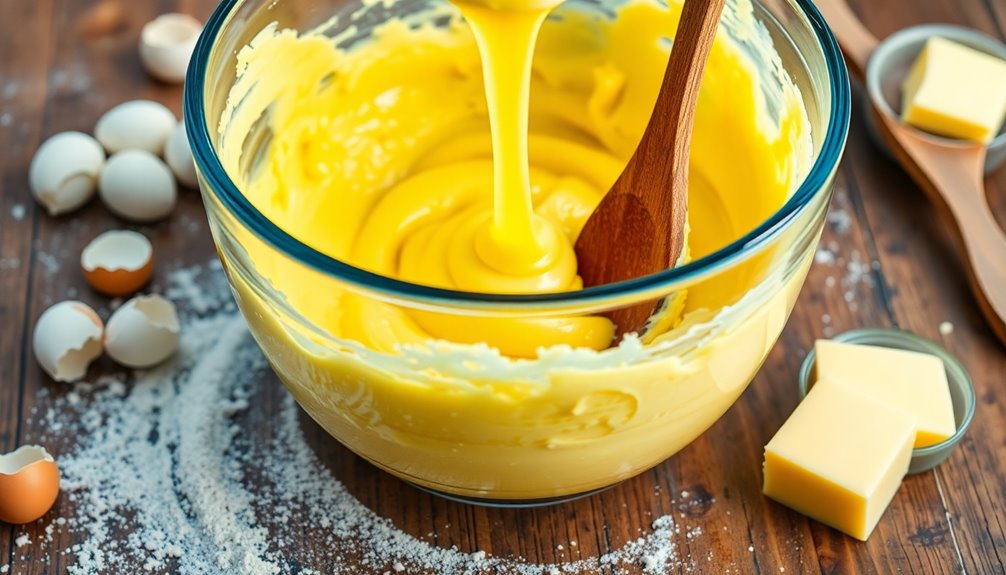
Incorporating butter into your batter is a key step that can elevate your dessert to new heights. To achieve that rich butter flavor, start with softened butter at room temperature.
Use a spatula or wooden spoon to gently fold in the butter, maintaining air pockets for a lighter texture. Avoid vigorous stirring—this can deflate your batter and compromise its rise and texture.
If your recipe calls for melted butter, let it cool slightly before folding it in to prevent cooking any eggs or creating a greasy mess. Aim for a homogenous mixture where the butter is evenly distributed throughout, ensuring that signature moistness in your baked goods. Additionally, using cultured butter can enhance the depth of flavor in your dessert.
Your dessert will taste even better with this careful incorporation.
Step 5. Add Flavor Extracts Next
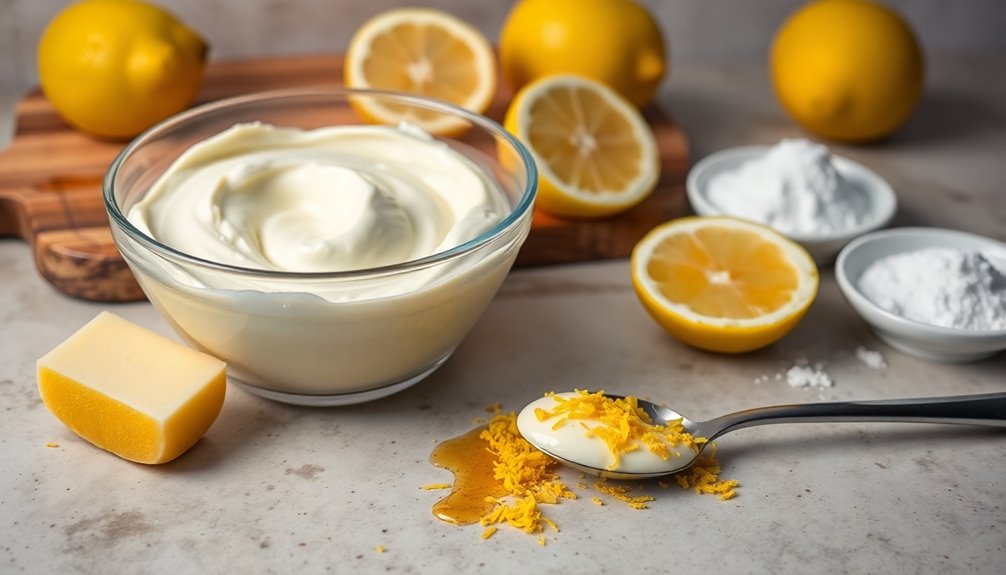
Once your butter is folded in and your batter is taking shape, it's time to boost the flavor. Start by adding flavor extracts like vanilla, almond, or lemon during the creaming stage with sugar. This ensures even distribution, enhancing your butter cakes with depth and complexity.
A teaspoon per cup of batter is a good guideline, but feel free to adjust based on your taste preferences. If your recipe has a lot of liquid, consider reducing other liquids slightly to maintain the right consistency.
Don't hesitate to experiment with combinations, like pairing vanilla with almond or citrus, to create unique and delightful flavors in your buttery desserts. Your taste buds will thank you!
Final Thoughts
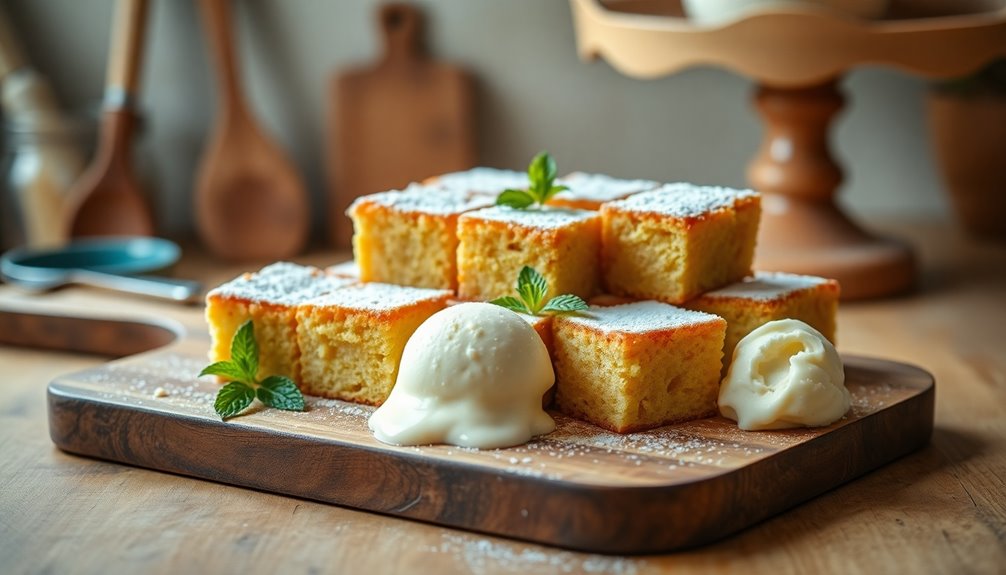
As you explore the world of 5-ingredient desserts, you'll find that simplicity can lead to delightful flavors and textures. The gooey butter cake is a perfect example, showcasing how the right amount of butter elevates a dish.
With just five ingredients, this cake isn't only easy to make but also creates a rich and indulgent treat. The recipe makes use of butter's natural richness, turning basic components like flour and sugar into something extraordinary.
Don't hesitate to experiment; adding seasonal ingredients or flavor extracts can make your desserts more unique. Remember, the magic lies in the balance of flavors and textures, so embrace the buttery goodness and enjoy every delicious bite. Additionally, using grass-fed butter can enhance the nutritional profile of your desserts, providing extra omega-3 fatty acids for added health benefits.
Frequently Asked Questions
What Recipes Use Browned Butter?
Imagine standing over a bubbling cauldron, coaxing a nutty elixir from butter.
You can incorporate browned butter into a variety of delicious recipes.
Try making Brown Butter Chocolate Chip Cookies for a delightful contrast of crispy edges and soft centers.
You might also enjoy Brown Butter Cookies or enhance a Gooey Butter Cake for a unique twist.
Don't forget to experiment with Banana Bread Bars topped with Brown Butter Frosting for an unforgettable treat!
What Does Butter Do in Desserts?
Butter plays a crucial role in desserts by enhancing flavor and texture. It adds richness that makes your treats indulgent, while also contributing to a tender, moist crumb that melts in your mouth.
When you use butter, you're creating flaky pastries by separating dough layers, ensuring a light and airy result. Plus, it acts as a binding agent, helping all the ingredients come together for a cohesive and satisfying dessert experience.
What Can We Bake Without Butter?
You might think baking without butter compromises flavor, but that's not the case!
You can create delicious treats using alternatives like vegetable oil, applesauce, or yogurt. For cookies, try margarine or coconut oil for similar results.
In cakes, sour cream or buttermilk keeps them moist. If you're feeling adventurous, experiment with nut butters or avocado puree for a rich, dairy-free twist.
Your desserts will still shine with flavor and texture!
What Pairs Well With Brown Butter?
When you're working with brown butter, consider pairing it with warm spices like cinnamon and nutmeg to enhance its nutty flavor.
Chocolate is another great match, deepening the taste in your brownies or cookies.
Fruits like apples and bananas offer a lovely contrast, while nuts such as walnuts and pecans add crunch.
Finally, integrating dairy components like cream creates a luxurious balance, elevating your desserts to a whole new level.




